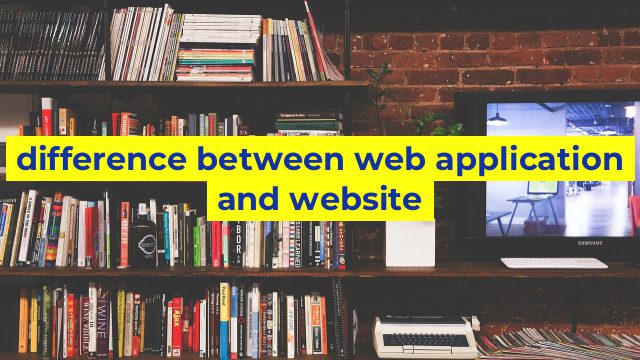Difference Between Web Application and Website
In today’s digital age, websites and web applications are two terms that are frequently used interchangeably. However, they are not the same thing. Understanding the difference between the two can be crucial to deciding which one is the best fit for your business.
Websites
A website is a set of web pages that are tied together under a single domain name. It is designed to provide information about a particular organization, product or service. Websites are created using a combination of languages such as HTML, CSS, and JavaScript.
A website follows a linear structure of information presentation – it is designed in a way that the user navigates from one page to another, accessing content or services as needed. A website can be static, dynamic or a combination of both. Static websites display the same content to every user while dynamic websites provide content based on user data and interaction.
Web Applications
A web application is an interactive program that is delivered over the internet. It is designed to perform a specific function or provide a particular service, such as email, social media or an e-commerce platform. Web applications are more complex than websites and require multiple technologies and development tools.
Web applications offer personalized user experiences with features and functions that are customized to meet specific user needs. Unlike websites, web applications usually require user authentication and can handle large volumes of user data. They can also integrate with databases, APIs, and other web services to provide a richer user experience.
The Verdict
While both websites and web applications serve distinctly different purposes, they can overlap in terms of functionality. Websites tend to be simple and information-oriented, while web applications are interactive and service-oriented. Depending on your organization’s needs, you may choose a website or a web application to serve your target audience.
In conclusion, websites and web applications both play a crucial role in today’s digital landscape, and understanding their differences can help you make an informed decision about which one is the best fit for your business.
Table difference between web application and website
| Category | Web Application | Website |
|---|---|---|
| Purpose | Designed to provide functionality to users to accomplish specific tasks or solve specific problems, often with a wider range of complex features and functionalities | Designed to provide information to users, often with a simpler design, focusing more on content delivery rather than interactivity |
| User Interaction | Requires more user interaction to complete specific tasks or achieve desired results, usually involving multiple pages or steps to complete a specific workflow | Requires less user interaction and typically focuses on presenting information rather than guiding users through a specific process |
| Data Storage | Often require a database or extensive API integration to support their complex functionalities, allowing users to input, manipulate, and retrieve data as part of a larger system | Usually serve as a simpler platform for presenting content or information, with limited data storage, often through a content management system (CMS) |
| Performance and Scalability | Generally require more resources and complex programming to ensure high performance and scalability for demanding user workflows and processes | Often prioritizes simplicity and speed of delivery over complex performance and scalability |
| Examples | Online banking systems, e-commerce platforms, social networking sites, project management tools, online collaboration platforms | News sites, blogs, brochure sites, informational sites, personal websites |

